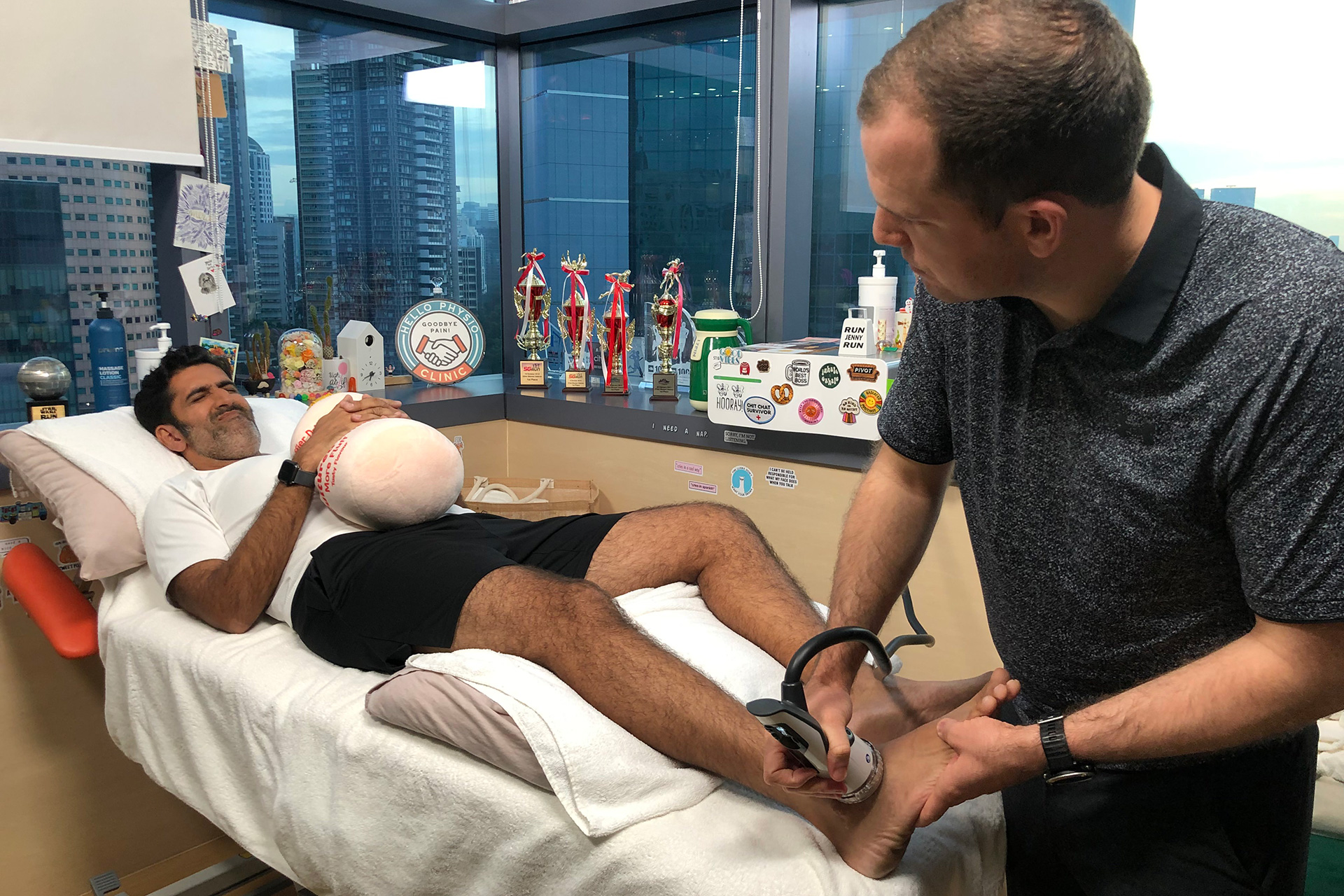What Is Plantar Fasciitis
Plantar fasciitis is one of the most common causes of heel pain, affecting millions worldwide. Approximately 2 million patients are treated for plantar fasciitis each year. The common symptoms include heel pain, stiffness and discomfort, especially in the morning, or after periods of inactivity. Plantar fasciitis occurs when the thick band of tissue along the bottom of the foot becomes inflamed, usually from repetitive strain or excessive stress.
The main complaint is foot pain, often localized to the heel and bottom of the foot. For athletes, runners, and individuals who participate in sports that involve running, as well as those who spend long periods standing or walking, plantar fasciitis pain can quickly escalate from a mild nuisance to a debilitating condition that significantly impacts daily activities and mobility.
The symptoms of plantar fasciitis typically include pain that is worst in the morning and may worsen with activity throughout the day. Left untreated, it can linger for months or even years, making early diagnosis and targeted treatment essential.
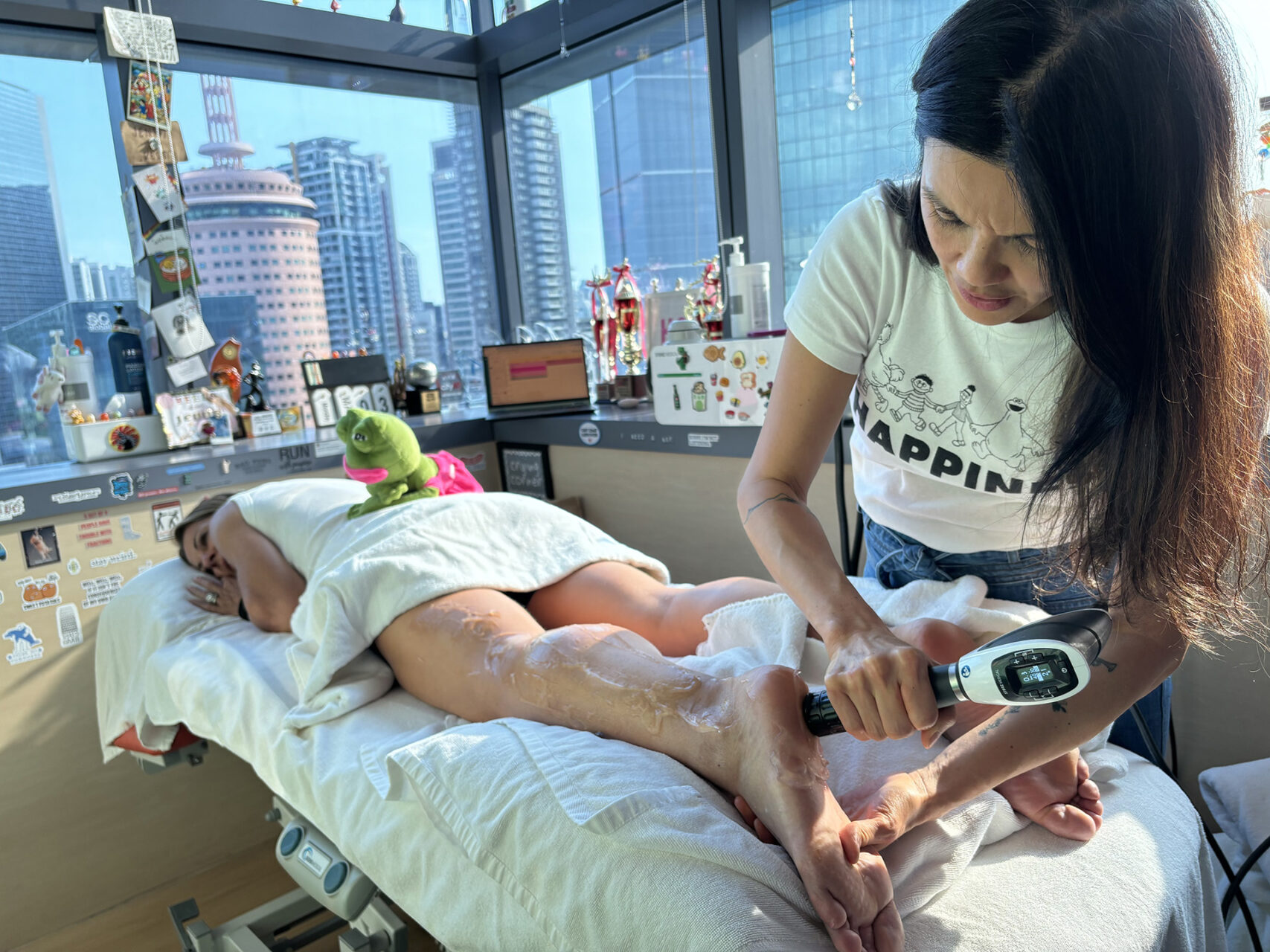
Anatomy and Function of the Plantar Fascia
The plantar fascia is a strong, fibrous band of tissue that runs from the heel bone to the base of the toes. It supports the arch of the foot and acts as a shock absorber with every step. The plantar fascia supports the arch of the foot and connects the heel to the front of the foot.
The Achilles tendon, which connects the calf muscles to the heel bone, plays a crucial role in foot biomechanics. A tight Achilles tendon can increase the risk of developing plantar fasciitis by altering the way forces are distributed across the foot. When functioning properly, the plantar fascia allows for efficient walking, running and jumping.
Excessive stress or overuse can create tiny tears in the fascia, leading to inflammation and pain. At the attachment point of the plantar fascia to the heel bone, a bony growth known as a heel spur can sometimes form, especially in response to repetitive pulling of the fascia. The unique structure of this tissue means that recovery is often slow without proper intervention, especially since the feet bear the body’s weight during almost every movement.

What Causes Plantar Fasciitis
The most common causes of plantar fasciitis involve repetitive strain from activities such as standing, walking or running, especially on hard surfaces. Overuse can lead to damaged tissue in the plantar fascia, resulting in pain and inflammation. Foot mechanics also play a significant role. Flat feet, high arches and overpronation alter weight distribution, resulting in excessive tension in the fascia.
Chronic tension over time can contribute to the development of a heel spur, a bony growth on the heel bone often associated with plantar fasciitis. Wearing unsupportive shoes or suddenly increasing activity levels, such as ramping up running mileage, can also trigger inflammation.
Risk factors include walking barefoot on hard surfaces and wearing flip-flops, both of which lack proper support and can increase the likelihood of foot problems. Occupational demands, such as prolonged standing in factory or service jobs, further increase the risk.
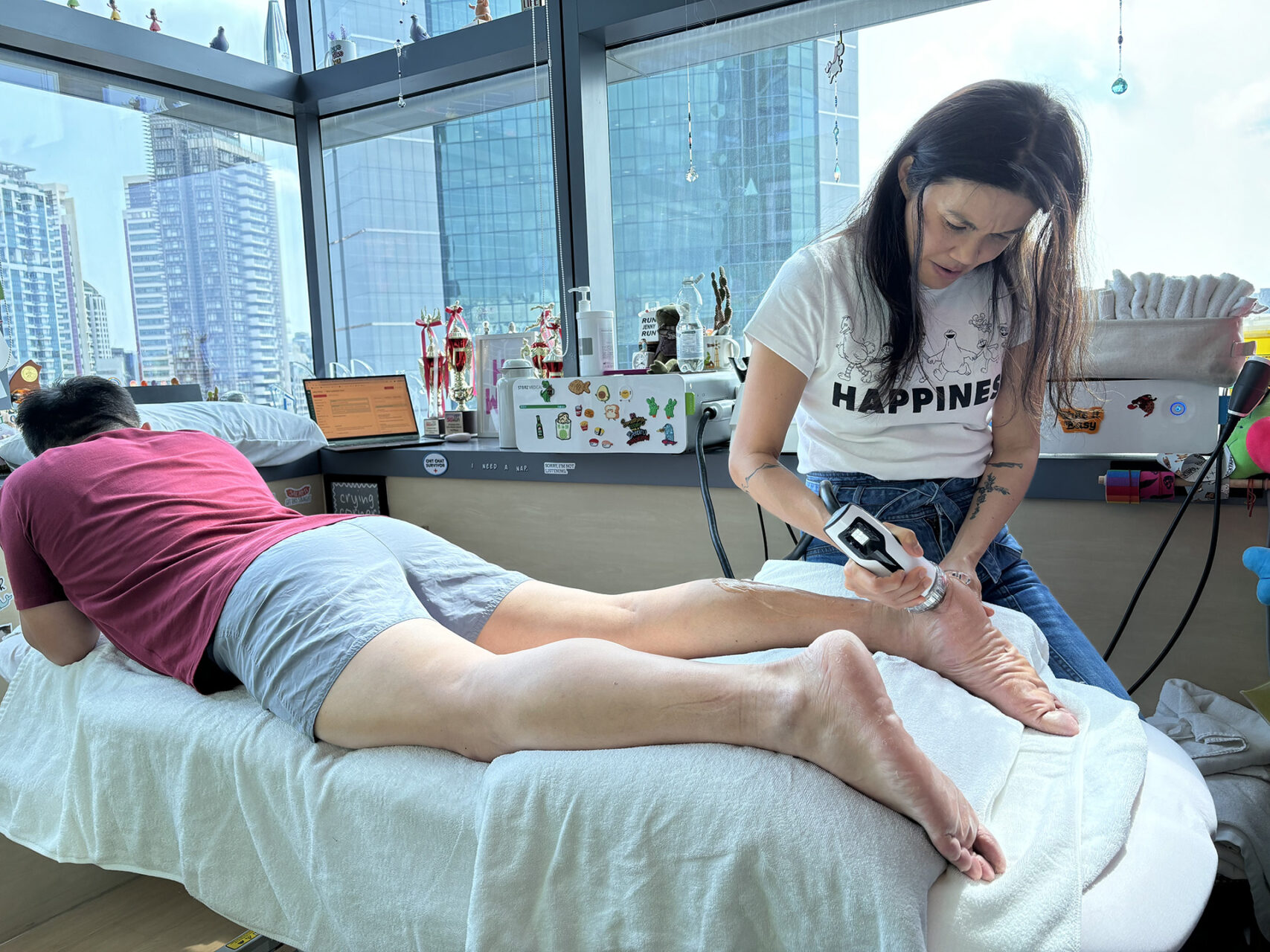
Risk Factors
Several factors make some individuals more prone to developing plantar fasciitis:
- Age-related changes in tissue elasticity mean people between 40 and 60 often experience this condition.
- Jobs that require prolonged standing, such as teaching or retail work, put persistent stress on the plantar fascia.
- Athletes in high-impact sports, such as basketball or long-distance running, face higher risk, especially if training surfaces are hard or uneven.
- Excess body weight increases load on the fascia, while poor footwear, especially unsupportive flats or worn-out running shoes, exacerbates strain. Plantar fasciitis can affect both feet in about one-third of cases.
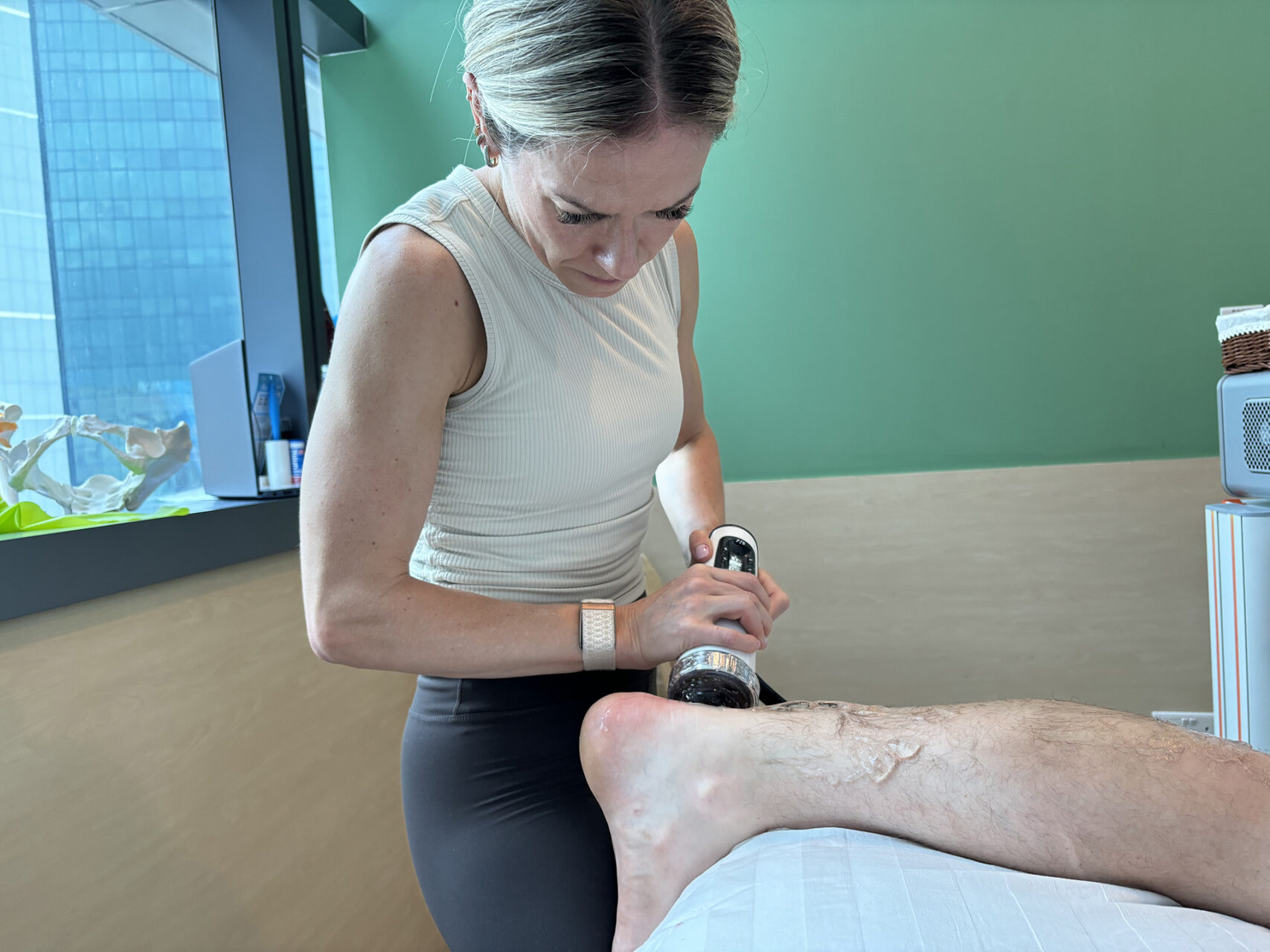
Plantar Fasciitis Symptoms and Heel Pain
Plantar fasciitis symptoms typically begin with sharp heel pain during the first steps of the morning or after prolonged periods of sitting. Pain is usually the worst first thing in the morning and eases after a few minutes of walking. This discomfort often eases as the foot warms up, but it can return after extended periods of standing or activity. Tenderness is usually felt along the heel or arch, and the pain can range from a dull ache to stabbing discomfort. Without treatment, the condition may progress, leading to a painful foot that interferes with daily activities and causes persistent or worsening pain that affects gait and posture.
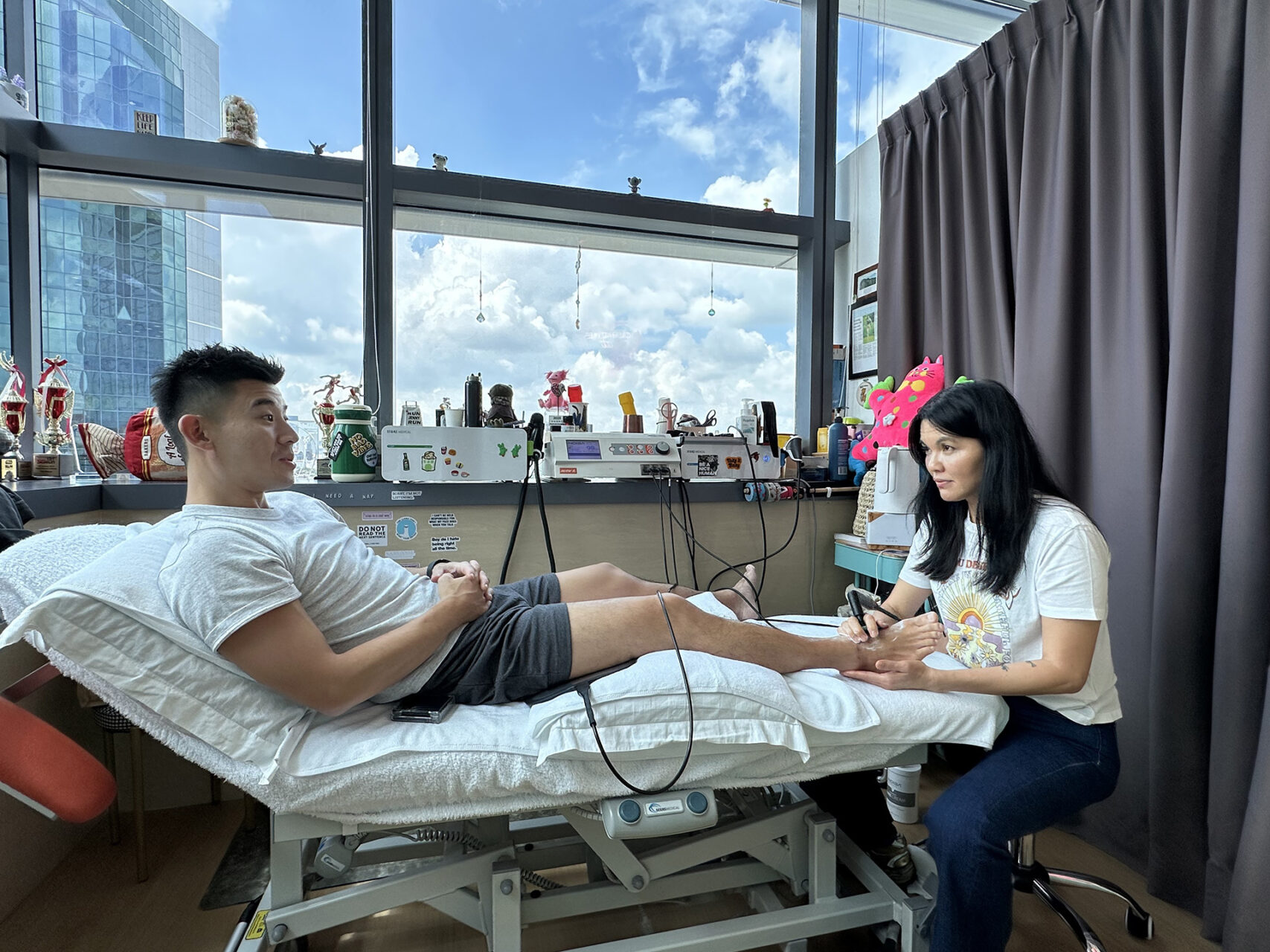
Associated Conditions
Plantar fasciitis rarely occurs in isolation and is often associated with other foot disorders that can complicate both diagnosis and treatment. One common association is with heel spurs, or bony growths that develop on the heel bone. While heel spurs themselves may not always cause pain, they often appear alongside chronic plantar fasciitis and can intensify discomfort in the affected foot. Flat feet, or low arches, are another risk factor, as they place extra strain on the plantar fascia, thereby increasing the likelihood of inflammation and persistent pain in the plantar fasciitis.
Tight calf muscles can also contribute to plantar fasciitis symptoms by limiting ankle flexibility and increasing tension on the plantar fascia with every step. In some cases, a plantar fascia rupture, where the thick band of tissue tears wholly or partially, can occur, leading to severe pain and a prolonged recovery process. Additionally, conditions like Achilles tendonitis, which involves inflammation of the tendon connecting the calf muscles to the heel, can coexist with plantar fasciitis, further exacerbating heel pain and complicating treatment.
Recognizing and addressing these associated conditions is crucial for effective management. A comprehensive approach that targets not only the plantar fascia but also related foot and lower leg issues can help reduce pain, restore function and prevent future flare-ups.
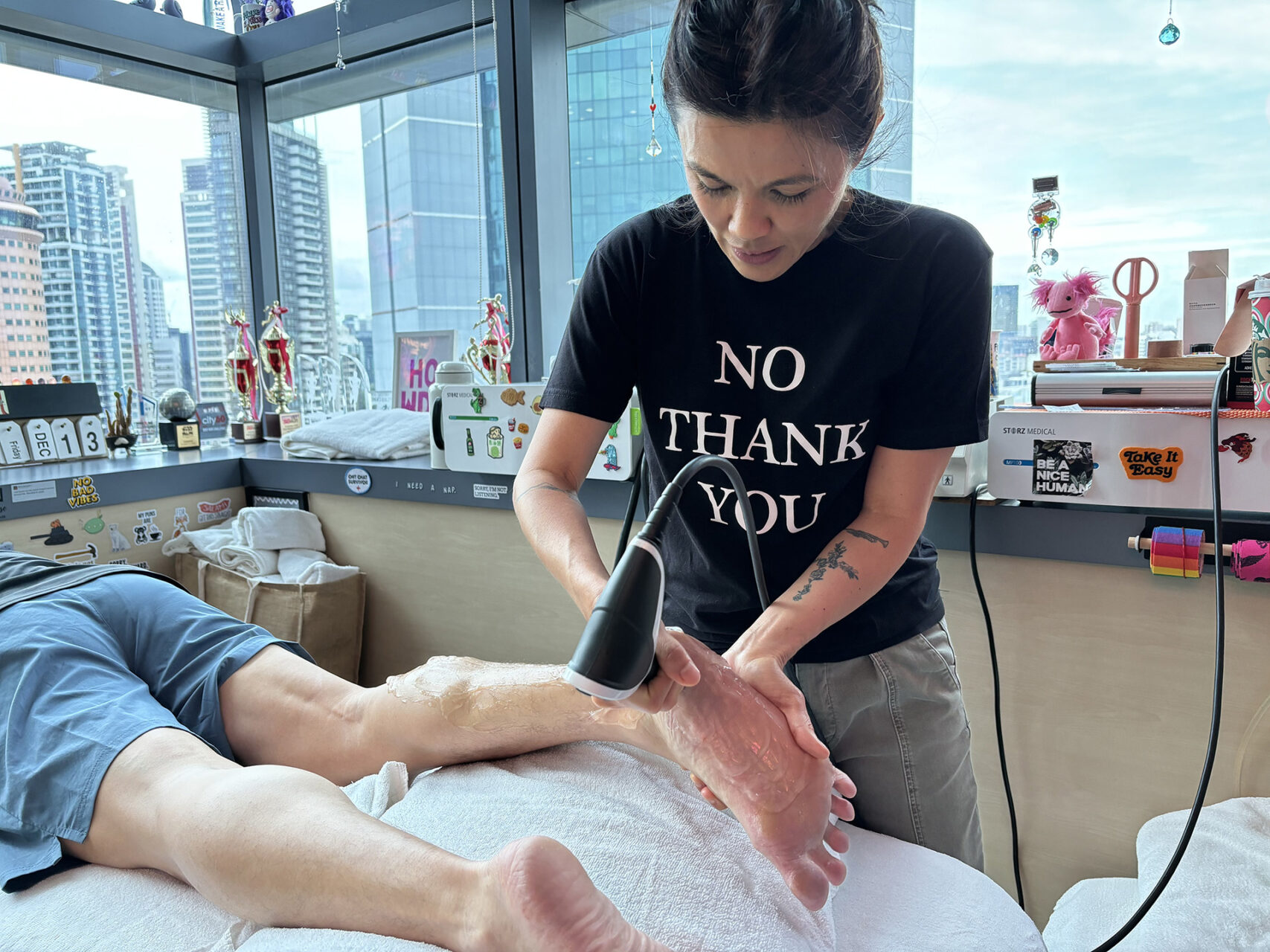
Diagnosis
Diagnosing plantar fasciitis begins with a physical examination, where a clinician checks for tenderness along the plantar fascia and evaluates foot mechanics. Other causes of heel pain, such as stress fractures or nerve entrapment, are ruled out. While imaging is not always necessary, an ultrasound or MRI can confirm chronic cases or assess for complications, especially when standard treatments fail to provide relief.
X-rays are commonly used to check for heel spurs or other bone spurs on the heel bone, which may be contributing to heel pain. Although X-rays do not directly visualise the plantar fascia itself, they help rule out other potential causes of pain, such as fractures or bony abnormalities.
Ultrasound imaging provides a detailed view of the plantar fascia, revealing thickening, inflammation or small tears in the tissue. This non-invasive test is beneficial for assessing the extent of damaged plantar fascia tissue and monitoring the healing process over time. In more complex cases, magnetic resonance imaging (MRI) may be recommended. MRI provides detailed images of both soft tissue and bone, helping to confirm the diagnosis of plantar fasciitis and identify any additional issues, such as Achilles tendonitis or severe inflammation.
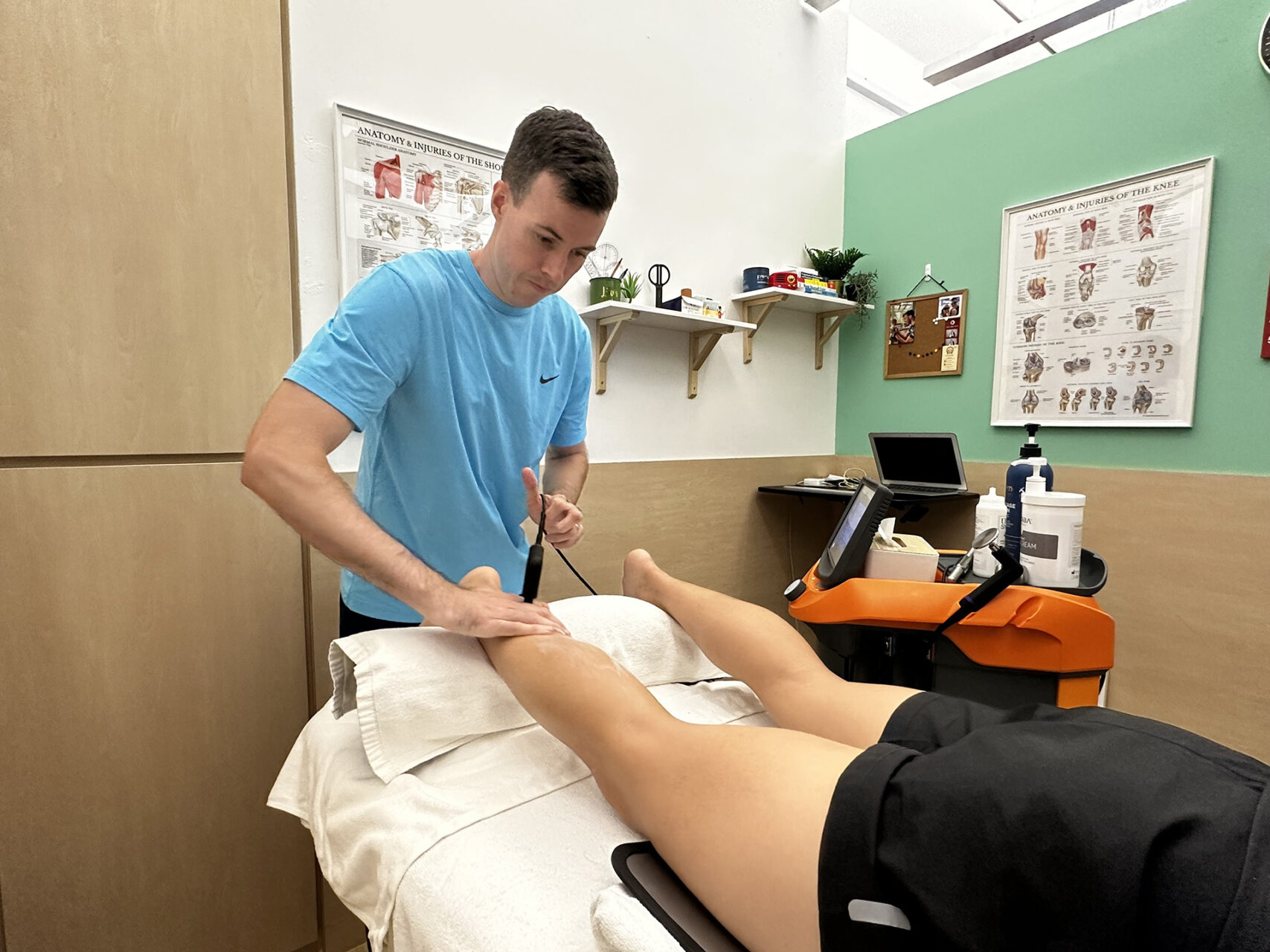
Plantar Fasciitis Treatment
Plantar fasciitis treatment typically begins with conservative measures, including reducing activities that aggravate symptoms, applying ice and performing targeted plantar fasciitis stretches to ease tension in the plantar fascia. Modifying footwear, such as using cushioned shoes or custom orthotics, can improve alignment and reduce strain. Using shoe inserts and shoes with thick soles provides additional support and cushioning, helping to decrease tension on the plantar fascia during daily activities.
Physiotherapy plays a central role in recovery, combining manual therapy, exercise prescription and gait retraining. Physical therapy can help stretch and strengthen the foot and calf muscles, as well as utilize modalities like massage to reduce inflammation and promote healing. In severe cases, a walking boot may be used to immobilize the foot and offload stress during recovery. Nonsurgical treatments often improve plantar fasciitis within 10 months for over 90% of patients.
For persistent cases, adjunctive modalities can significantly accelerate healing:
Shockwave Therapy Targets Cellular and Tissue Response
Shockwave Therapy is a noninvasive treatment option for plantar fasciitis that uses high levels of targeted acoustic energy to promote healing and reduce pain. It effectively improves foot function in patients with plantar fasciitis, either as a standalone treatment or in combination with routine care such as exercise and physical therapy.
Shockwave Therapy generates interstitial and extracellular responses, producing beneficial effects such as pain relief, vascularization, protein biosynthesis, cell proliferation, neuro and chondroprotection, and breakdown of calcium deposits in musculoskeletal structures. These effects can lead to tissue regeneration and significant pain alleviation, improving functional outcomes in injured tissue.
The proposed mechanism of action for Shockwave Therapy is based on mechano-transduction, where the delivery of mechanical acoustic energy to the target tissue induces molecular, cellular and tissue responses.
Shockwave Therapy has also been shown to promote the expression of various angiogenic and osteogenic growth factors, such as vascular endothelial growth factor (VEGF) and bone morphogenetic protein (BMP), further promoting tissue regeneration. Additionally, Shockwave Therapy is anti-inflammatory by modulating the expression of interleukins (IL-6 and IL-10) and other cytokines.
INDIBA Stimulates Cell Regeneration Naturally
INDIBA® Therapy uses radiofrequency energy to stimulate stable cell regeneration without heat effect. The thermal effect of INDIBA® increases vascularization and oxygenation of body tissues, improving local blood circulation, healing damaged tissues, and reducing swelling and pain.
The therapy also boosts cellular metabolism, increases fibroblast activity, and accelerates collagen production within the treated tissues, aiding in repairing damaged knee structures and restoring elasticity. Additionally, INDIBA® Therapy reduces nerve fiber activity in the area, diminishes pain sensations and addresses inflammation at its source, offering substantial relief from discomfort.
Prescribed Physical Therapy Exercises
Stretching exercises are particularly effective in alleviating the symptoms of plantar fasciitis. The top five exercises for this condition include a gastrocnemius stretch, where the patient stands on the edge of a step or box and slowly lowers their heels to stretch the calf muscles. A toe curl with a towel where the patient curls a towel towards them using only their toes helps strengthen the foot muscles. Toe extension exercise is when the patient bends their toes and ankles upwards as far as possible to stretch the arch and calf muscles. These exercises are designed to target the muscles and tissues that support the arch of the foot, providing relief from plantar fasciitis symptoms. Before starting any exercise routine, it is important to consult with a physiotherapist to ensure the exercises are suitable for your specific biomechanics.
Benefits of Sports Massage Your Heel Pain
Sports massage is a helpful method for managing plantar fasciitis pain caused by the shortening and stiffening of the plantar fascia. The deep massage techniques break down the scar tissue on the fascia, improving blood flow and lymphatic circulation and enhancing the absorption of oxygen and reparative nutrients to the area. The physiological benefits of sports massage for heel pain include increasing blood circulation, reducing pain signals via the pain gate theory, and temporarily relieving chronic pain conditions. Sports massage can also be part of a holistic treatment plan for plantar fasciitis.
Red Light Therapy to Reduce Inflammation
Red Light Therapy is a non-invasive treatment that reduces inflammation, speeds tissue repair, decreases pain in patients with plantar fasciitis, and improves skin health. In managing plantar fasciitis, Red Light Therapy penetrates deep into the tissue, alleviating inflammation, reducing pain, and enhancing healing. The therapy harnesses the power of red and near-infrared light, which can aid in accelerating tissue healing.
Dry Needling Therapy Targets Trigger Points, Reduces Pain
Dry needling is a treatment option that involves the insertion of thin needles into specific trigger points in the foot and heel to alleviate pain associated with plantar fasciitis. This therapy can relieve symptoms by eliciting a local twitch response, improving blood flow, and altering nerve signals. Dry needling can effectively reduce the pain associated with plantar fasciitis by targeting trigger points in the foot and calf muscles, which in turn helps relieve tension and reduce inflammation in the plantar fascia. Additionally, combining dry needling with other treatments, such as physical therapy and stretching exercises, can enhance its effectiveness.
Surgical treatment is considered for patients who do not respond to nonsurgical methods. Common procedures include gastrocnemius recession, which involves lengthening the calf muscle to reduce tension on the plantar fascia, and partial plantar fascia release. These surgeries can be performed using open or endoscopic techniques, but may carry potential complications, as with any surgery.
Most patients with plantar fasciitis recover well with appropriate treatment, especially when conservative approaches are used first.
Book an Appointment
Plantar Fasciitis Exercises
Plantar fasciitis exercises focus on both stretching and strengthening the affected area. Gentle calf and plantar fasciitis stretches help restore flexibility, especially when performed in the morning or after a period of prolonged rest. Rolling the arch over a frozen water bottle or massage ball can ease tightness and improve blood flow.
Strengthening the small muscles in the foot, for example, by performing towel curls or picking up marbles with the toes, helps build resilience and support the arch of the foot. Over time, functional drills like single-leg balance work prepare the foot for more demanding activities, reducing the risk of reinjury.
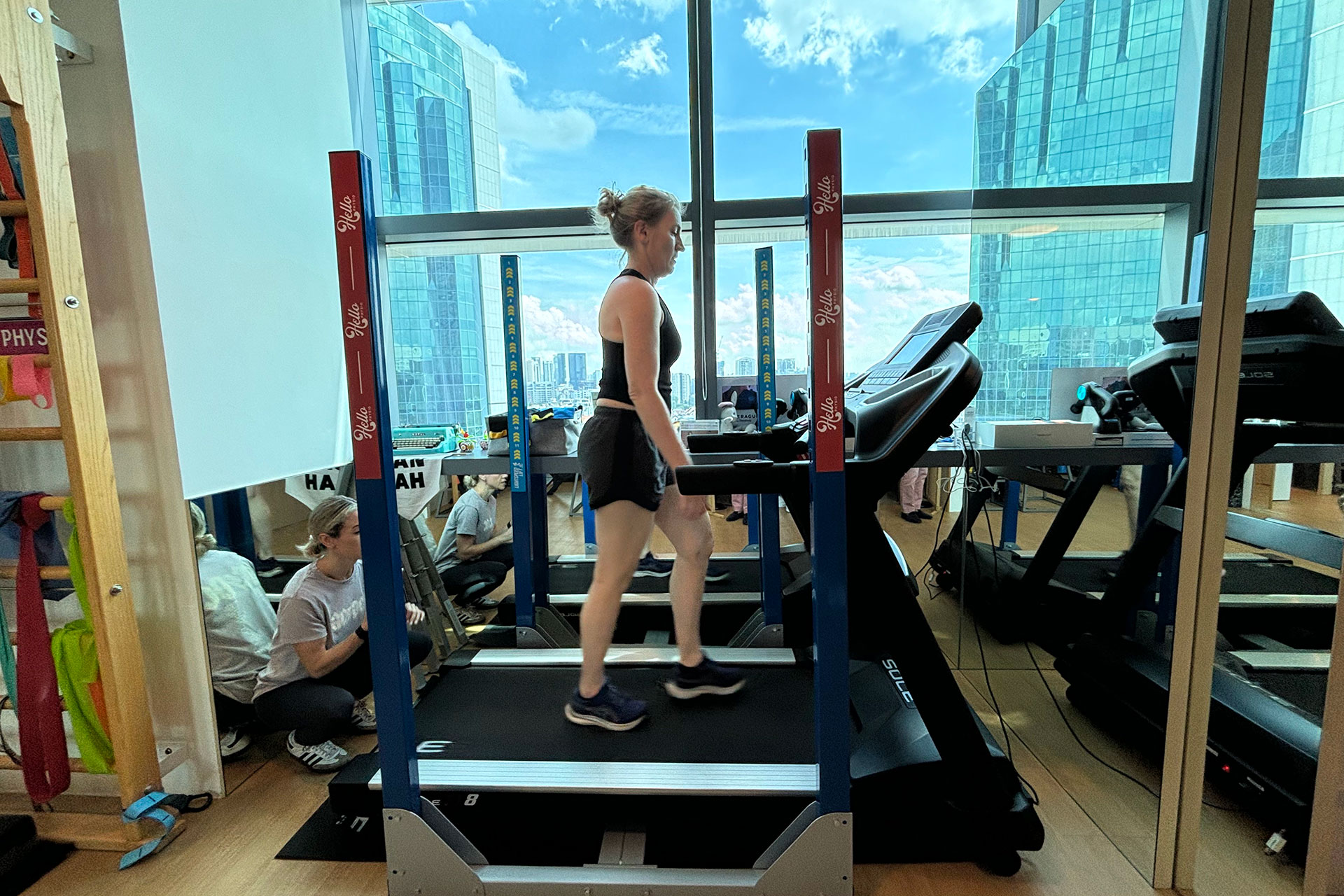
Recovery Time for Plantar Fasciitis
Recovery time varies depending on the severity of the condition, compliance with treatment, and lifestyle factors. Many cases resolve within 6 to 12 weeks with consistent conservative care, while chronic plantar fasciitis can persist for months. Factors such as high activity levels, poor footwear or biomechanical issues can prolong the healing process. Incorporating advanced therapies, such as Shockwave, INDIBA, and EMTT, may shorten recovery time by accelerating tissue repair and reducing pain, allowing for an earlier return to normal activities.
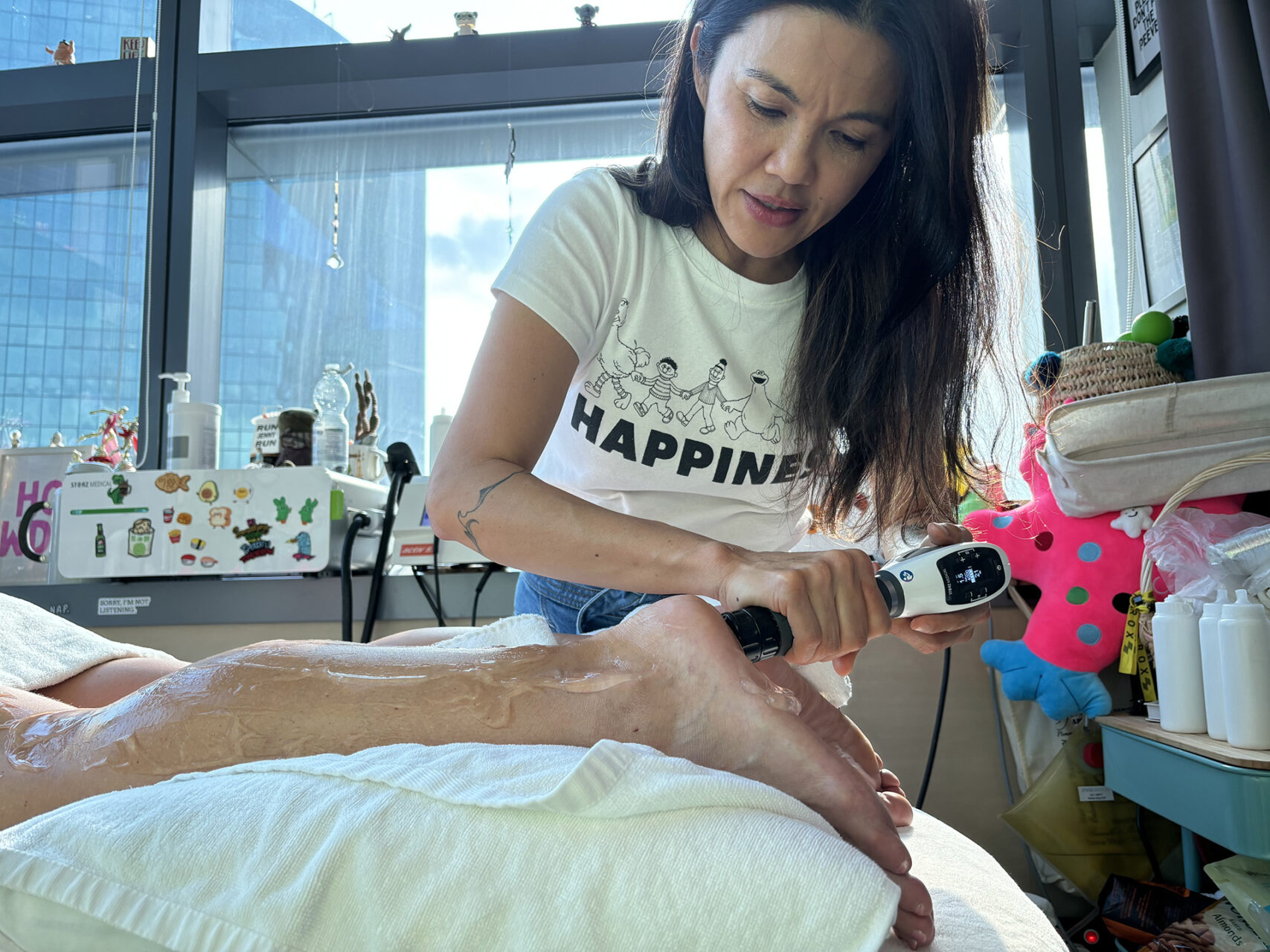
Prevention Tips
Preventing plantar fasciitis requires a proactive approach. Maintaining flexibility in the calves and plantar fascia through regular stretching reduces tension during movement. Strengthening the foot’s intrinsic muscles and the calf complex improves shock absorption and arch stability.
Wearing supportive shoes that match your foot type and replacing worn-out footwear before cushioning breaks down can make a substantial difference. Gradually increasing training loads helps the fascia adapt to higher demands without becoming overloaded. Addressing biomechanical issues early, often with the help of a physiotherapist, prevents minor irritation from becoming a chronic problem.
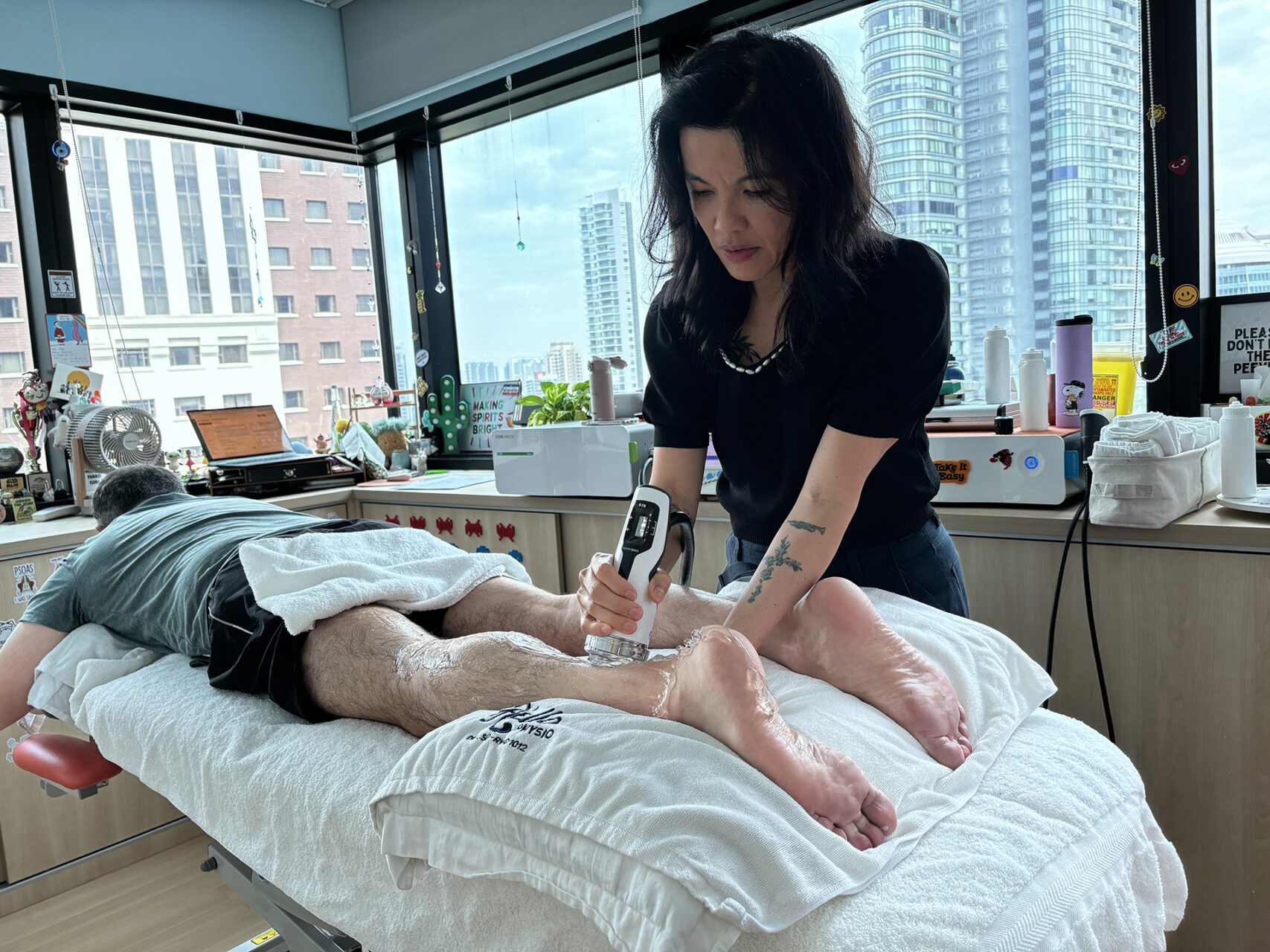
When to See a Physiotherapist
If plantar fasciitis pain lasts more than two to two weeks despite rest and self-care, or if it interferes with daily activities or exercise, it’s time to consult a professional. Persistent or worsening symptoms may indicate a more complex issue that requires targeted intervention. Signs of chronic plantar fasciitis, such as ongoing stiffness or arch collapse, need thorough evaluation to prevent long-term disability.
Combining manual therapy, targeted exercises, and advanced treatments like Shockwave Therapy, INDIBA Activ and EMTT not only speeds healing but also addresses underlying biomechanical issues to prevent recurrence. If you are struggling with plantar fasciitis symptoms or want expert guidance on prevention, book a consultation with HelloPhysio today.

